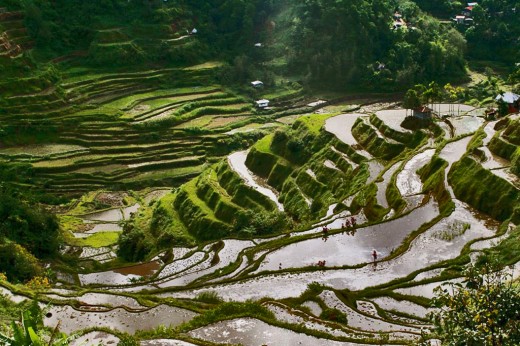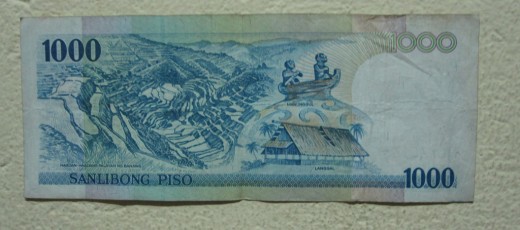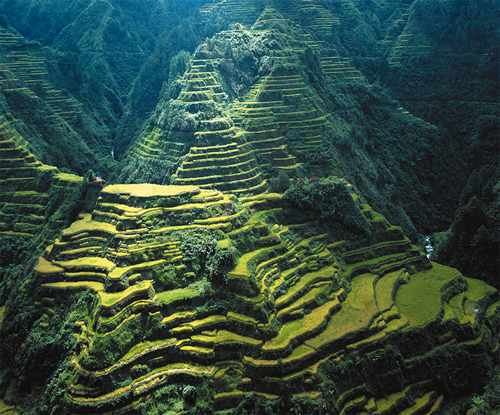Considered as the eighth wonder of the world, the Banaue Rice Terraces is one of the Philippines‘ most admired and most visited tourist attractions. This panoramic beauty was built over 2000 years ago by the Ifugao tribes with only primitive tools such as stones and woods. This exquisite beauty gives a glimpse, to everyone who visits the place, how intelligent and great the engineering skills of native Filipinos. The Banaue Rice Terraces was declared a World Heritage Site by the UNESCO (United Nations Educational, Scientific and Cultural Organization) in the year 1995.
Without machinery, the Ifugao tribes wonderfully carved this Banaue Rice Terraces into perfection out of the hillside. This is where the natives plant their rice and use it for food. Up until today, the same rice terraces is maintained and planted with rice and vegetables for consumption and export.
Because planting rice is not appealing to most of the younger Ifugaos, most of them went to tourism and hospitality service by helping locals and foreigners alike to get to know the place a little better. Some of the Ifugaos went to nearby urban cities to find better opportunities and high paying jobs than planting rice and vegetables.
It was believed that a group of migrating people carried the terrace culture from South China or Indo-China across to Luzon and Southern Japan, and southward to Java and the Lesser Sunda Islands – which are the only regions where true rice terraces existed. Remains indicate that the first migration was probably in the second millennium B.C. and carried only a material culture of polished stone, copper, and bronze. A second migration, the later part of the first millennium B.C., brought also the use of iron, pottery, and woven cloth. The Banaue people represent the oldest native folk and those of central Ifugao are the typical carriers of the terrace culture. Those of the Kiangan district are the latest comers in the region.
Known locally as the “hagdan-hagdang palayan ng banawe”, the Banaue Rice Terraces were largely built by hand by the ancestors of the indigenous people. Until today this wonderful creation remains sturdy in the Ifugao Mountain. Four viewpoints have been made to provide breathtaking views. The higher you get the better the view of the Banaue Rice Terraces. The best time of the year to visit Banaue is June-August where the rice starts to grow and the dense green leaves is vastly seen.
Located 5000 feet above sea level and covers 10,360 square kilometers of mountainside, the Banaue Rice Terraces is fed by an ancient, sophisticated irrigation system made from bamboo tubes coming from the rainforest above the terraces. According to folklore, if the steps are put end to end it would encircle half the globe.
Recently, due to fewer farmers planting rice and vegetables to the Banaue Rice Terraces, it suffered gradual erosion and some of the mud-walled steps of the terraces had to be reconstructed and cared. Because of the El Niño phenomenon which happens mostly in March until May in the last couple of years, drought has been experienced and planting rice and vegetables have been very problematic.
The Banaue Rice Terraces is part of the Rice Terraces of the Philippine Cordilleras. They are spread in the provinces of Kalinga, Apayao, Benguet, Mountain Province and Ifugao. Previously this area belongs as a municipality to the Mountain Province, but now the Ifugao is an independent province.
Other than sight-seeing, a “Mumbaki” (traditional Ifugao witch doctor) is recommended by the townsfolk. These doctors can perform spiritual healing rituals. Hiking together with a local guide is also offered here. Domestic tourism has degraded in the past few years because locals are more interested in foreigners as they can ask for a higher pay. The tourism association of Banaue has been acting on this situation and slowly regulating the rules and standard rates.
Together with the drawings of Manunggul (a jar considered as National Treasure of the Philippines) and Langgal (a hut and a place of Muslim worship), the Banaue Rice Terraces is found in one side of a “Sanlibong Piso” or One Thousand Piso Bill, the highest bill in the Philippines.
Notable rice terraces nearby Banaue Rice Terraces are Batad Rice Terraces, Mayoyao Rice Terraces, Hapao Rice Terraces and Kiangan Rice Terraces.
The vantage point is a 10-15 minute ride from the bottom. A tricycle can take you there at P180-P200 going forth and back. There are souvenir shops in most of these vantage points and one can take pictures together with a local dressed in Ifugao native clothing.
Getting to Banaue from Manila is taking a 9 hour bus trip. Dangwa Transit has daily trips going to Banaue Rice Terraces. The bus terminals are located along Dimalasang St., Sampaloc, Manila and Aurora Boulevard, Cubao, Quezon City. You can contact them at telephone numbers (+63)(2)(732-2879) and (+63)(2)410-1991. Alternatively, you can take the Auto Bus with Banaue Route. The terminal is at España Boulevard corner G. Tolentino St., Manila. The Auto Bus leaves Manila at 10 pm and arrives 7am. You can contact them at telephone number (+63)(2)735-8098. The travel will pass through the provinces of Bulacan, Nueva Ecija, Nueva Vizcaya then to Ifugao.
Accommodation at Banaue is no problem. A lot of hotels and inns are found in the town center. The most popular hotel in town is Uyami’s Greenview Lodge (386-4021). A twin-sharing room without bathroom is P400 while the one with bathroom is P800 or P1500 depending if it has a view or not. People’s Lodge and Restaurant (386-4014) has rooms priced at P400-P500. Sanafe Lodge and Restaurant (386-4085), Halfway Lodge and Restaurant (386-4082), Stairway Lodge and Restaurant are other options. If you want luxurious rooms try Banaue Hotel (386-4087), their rooms are priced at P2500-P3200. Banaue View Inn (386-4078) sits on top of a mountain overlooking Banaue Rice Terraces and town with prices at P800-P900. Native Village Inn and Family Inn are additional options.
This page is last updated on



 Mark Anthony Maranga is an Educator-Parent to his 3 Homeschooling Kids. He sells
Mark Anthony Maranga is an Educator-Parent to his 3 Homeschooling Kids. He sells 











Planning to go to Banaue in Dec12 or Jan13. I have read that these are not the best months to see the rice terraces. Any other recommended places to see on those months? Those are the only months that I can spare for my R&R trip. Thank you and best regards 🙂
Thanks for sharing the info which is very helpful. I would like to know what months are best to visit the Banaue Rice Terraces. How far is it from the city of Baguio?
Keep up the good work!!!! Mabuhay!!!!
thank you for sharing!
very excited for my next adventure!
proud to be part of a cultural heritage…thanks for sharing this to the world.. go pinoy!
thanks for the info but i need much more info for our play in our report about the setting which is banaue rice terraces
wwwwooooowwww!!!!!!!!!!!!!!!!!!!!!!!! so much love for banaue rice terraces, awesome!!!! thanks to your blog, will go there his November with my friends :))) love it :)))
thanks sa info para sa article namen sa school 🙂
thanks for the info..i badly need it since we will visit Banaue this coming May…it helps me a lot….
Great info, thanks! I always thought going to the Banaue rice terraces is tad difficult but with your info here, it’s actually manageable. We should raise awareness to conserve this national treasure, it’s a part of who we are as Filipinos, just like the Great Wall is to the Chinese. Again, thanks!
Thanks! Your article is very informative and helps me to know much more about what I need to know as far as visiting this area and what to expect for expenses. I really liked all of the detail you added here about the geography and history.